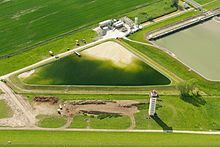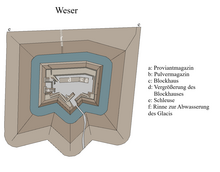Blexer Schanze

The Blexer Schanze (also "Franzosenschanze") was a fortress structure to protect the mouth of the Weser in Blexen . With the jumps at Großwürden , Groß-Fedderwarder, at the Waddenser pump and the jump on the Oberahnschen fields, it is one of the five "French jumps " of Butjadingen .
construction
The ski jump was located 750 meters northeast of the Blexer Church , directly on the Weser. The jump was surrounded by a trench about 7.2 meters wide and 4.5 meters deep. The structure had an almost square structure, three bastions protected the system on the land side. The middle bastion had a bridge that allowed access via a drawbridge from the west. Outside the trench there were glacis . A historical plan of the facility shows a powder and provisions magazine embedded in the inner wall, as well as a central log house . The log house was expanded in a second construction phase. The gate of the facility was additionally protected by a wall directly behind it.
Armament
The facility was equipped with six guns, four of which were cannons, two of which were mortars.
history
construction
The Blexer Schanze was built in connection with the fortification of the other side of the Weser on the Karlsburg area . In 1810 the ski jump in Blexen was built under the French commander Bernadotte to enforce the continental barrier imposed by France . The aim of the ski jump was to monitor the mouth of the Weser in order to prevent smuggling . It also served the military purpose of preventing the English from landing . The population of Blex was called in to build the defense works. Despite the ski jump, smuggling continued to take place in the mouth of the Weser.
revolt
After Napoleon's defeat in Russia became known, there were numerous uprisings in the occupied territories. On March 12, 1813, a revolt began on the fortresses on the other side of the Weser in Lehe by the German troops, which were monitored by only a few French. On March 18, the commandant of Karlstadt surrendered, his people were Germans who were already beginning to desert. On March 17, there was a revolt of coastal gunners at the Schanze in Blexen, too, they too were Germans. The French commander gave the gun leader Lübbe Eylers the order to shoot, but the latter refused to shoot at his compatriots. After the Blexers had expelled the French, they got reinforcements from Blexen "partly through amicable persuasion, partly under threat of violence" in order to set up the defense of the hill. On March 22nd, the English took the Karlsburg hill opposite. Contrary to the hopes of the rebels, however, the English did not get to the other side of the Weser. On March 24th the message arrived that a French column was on the way to Blexen, as a result of the news the women and children were evacuated from Blexen and the hill fortified. On their way to Blexen, the French troops demanded 12,000 Reichstaler from the city of Oldenburg , this amount should be paid within one day. The same demand for 12,000 Reichstalers was also made to the village of Blexen, which was only able to raise 1,000 Reichstalers with great hardship. On the march to Blexen, the French troops took hostages and the most respected residents of Oldenburg , Blexen, Brake , Elsfleth , Waddens and Berne had to be arrested.
Recapture
The French took back the fortresses in Lehe and Blexen on March 25th with about 1,000 men. Blexen capitulated in front of several hundred men consisting of infantry, customs officers and gendarmes. Immediately after the surrender, Lübbe Eylers was brought to the hill and shot in front of his 26 men. The remaining German rebels were arrested in the redoubt, and the village was looted at the same time. The next day the 26 men were brought in front of the church, two of them were chosen at random and shot in front of the church door until ten of them were dead. During the shooting, the hostages were forced to wave their hats and shout “Hurray”. Five of the other men were pardoned, the other eleven prisoners were handcuffed and transported away. Two of the prisoners were shot at Ovelgönne and two others in front of the Heiligengeisttor in Oldenburg. On April 5, five other prisoners were shot in Bremen. The official gazette of the “ Departement der Weser estuary ” reported a “complete happy success” and spoke of the punishment of “wretched farmers” when the rebels were killed. The shooting of the Butjadinger farmers in the churchyard in Blexen was expressed in a painting. The Blex church door, which served as a bullet trap, was later sold and fired.
On April 10, 1813, 50 customs soldiers and several thousand French troops came to Blexen, about 600 remained in the place. There was another looting. The ski jump has now been expanded into a fort .
End of the French period
Six months later, a month after the decisive battle near Leipzig , Russian troops under General Wintzingerode came as liberators on November 21 , they opened the gate of the Blexer Schanze with a cannon shot. The crew was taken prisoner. The Russians occupied the fort until December 5, 1813. With the return of Duke Peter Friedrich Ludwig, the widows and orphans of those shot received annual support.
Danish war
During the German war with Denmark from 1848 to 1851, the Franzosenschanze in Blexen became relevant again. Because Danish warships blocked the German estuaries when the war broke out. The coastal population feared landings and subsequent looting and should be reassured by the transfer of troops to the coast. On April 23, 1848, four Campania of the 1st Battalion, 2nd Regiment, were moved to the coast, they had half a battery . The 1st company with two guns was transferred to Blexen, the second to Brake , the third to Tossens and Varel and the fourth with two guns to Hooksiel . A first lieutenant Rüber was assigned to reach a position for six guns in Blexen at the place of the Franzosenschanze. In association with Fort Wilhelm and a battiere built by Prussia on the Bremerhaven harbor embankment , the Weser was supposed to be closed against attacks. The Blexer battery was to be equipped with some twenty-four pounder cannons from Hanover , but these were not available. Therefore, four of the iron twelve-pounders from Oldenburg were used, which arrived on May 13th. The armament was supplemented by two long thirty-two pounders and two eight-inch bomb cannons .
20th century
Several photographs of the Franzosenschanze have come down to us from the 20th century, at which point it had already fallen into disrepair and consisted only of a few tree-covered hills and ponds on the Blexer Groden. The teachers Pille and Klockgether from the Blexer School tried successfully to put the square under monument protection during the thirties . In 1936, the preparatory work for a major project on the Blexer Groden began. Under the guise of flood protection , the Groden was diked and flushed. The Air Force took over in 1938, it proposed here a large air base to build the "biggest Seflughafen of the continent". With the outbreak of the Second World War in the following year, the construction project was canceled because there were enough airfields in the conquered areas.
present
On the initiative of Robert Allmers , the Rüstringer Heimatbund erected a memorial stone at the Blex church in 1895. It bears the inscription: “Here on March 26, 1813 ten German men were shot as victims of French rule without investigation. Now protect Germany's unity from such disgrace us at any time. ”The writing is framed by two fasces .
The system was probably covered with a layer of mud during the excavation work on Blexer Groden, which took place in the 1930s, which is why it is only present below the ground and is therefore the subject of archeology .
literature
- Klaus Dede : Ten German men. The shooting of deserters in front of the Blex Church in 1813 or how a coffee revolt was turned into a German national uprising, Bremen 2001.
- Max Markreich: The will of Blexen. A reminder sheet of the Napoleonic era, in: The Oldenburg House Calendar 1990, pp. 32–35.
- Gerhard Fröhlich / Hans-Gottlob Schüler: 1200 Years of Blexen, Oldenburg 1988, pp. 161–165.
- Gustav Rüthning : Oldenburg History, Volume 2, 1911, p. 374 ff.
- Friedrich Reinhard Ricklefs : Abuse of the parish Blexen on the Weser, in the Duchy of Oldenburg. (A contribution to the history of the French tyrants in Germany) 3rd volume, 2nd issue, p. 3 f., In: Germania, Oldenburg 1815.
- Louis von Weltzien : Military studies from Oldenburg's prehistory and history of the Oldenburg contingent. Oldenburg 1858, pp. 265, 273.
swell
- NLA OL Order 298 Z No. 1629 (map of the Blexer Schanze)
- NLA OL Order 298 C 9 No. 23 (map of Blexer Groden with ski jump)
- NLA OL Order 298 VI No. 140 c (map of the mouth of the Weser with "Blexer Battery")
Individual evidence
- ↑ a b Gustav Rüthning: Oldenburgische history . tape 2 , 1911, p. 374 ff .
- ^ Frank Gosch: fortress construction on the North Sea and Baltic Sea. The history of the German coastal fortifications until 1918 . 1st edition. Mittler, Hamburg / Berlin / Bonn 2003, ISBN 3-8132-0743-9 , pp. 51-64 .
- ↑ a b c d e f g h i j k l 1200 years of Blexen . 1988, p. 161-165 .
- ^ Franz Buchenau: The Free Hanseatic City of Bremen and its Territory: A Contribution to the Geography and Topography of Germany. 1862, p. 256 .
- ↑ a b c d e Georg Bessell: The first 100 years of Bremerhaven . 2011, p. 109-111 .
- ↑ a b Max Markreich: The Testament of Blexen. A reminder sheet of the Napoleonic era . In: The Oldenburg House Calendar . 1990, p. 32-35 .
- ↑ a b c d Nistal: Oldenburgisches Ortlexikon AK . Oldenburg 2010, p. 93-98 .
- ↑ Klaus Dede: Ten German Men . Fischerhude 2001, p. 152 .
- ↑ Louis von Weltzien: Military studies from Oldenburg's prehistory and history of the Oldenburg contingent . Oldenburg 1858, p. 265 .
- ↑ Louis von Weltzien: Military studies from Oldenburg's prehistory and history of the Oldenburg contingent . Oldenburg 1858, p. 273 .
- ↑ Klaus Dede: Ten German men . Fischerhude 2001, p. 110 f .
- ↑ Ellmar Diers: carnage before Blexer Church . In: Norderwestzeitung / Wesermarsch-Zeitung . January 14, 1969, p. 14 .
- ↑ Norbert Hartfil: From megalomania on the Groden. In: Nordwestzeitung. July 25, 2013, accessed August 20, 2019 .
Coordinates: 53 ° 32 ′ 1.2 " N , 8 ° 32 ′ 53.1" E
